Strategic Change Management for Amazon
VerifiedAdded on 2023/06/12
|20
|4313
|198
AI Summary
This article discusses the models of strategic change, factors driving the need for strategic change, resource implications of not responding to strategic change, and more in the context of Amazon. It also explores the relevance of these models in the current economy and the value of using strategic intervention techniques in the organization.
Contribute Materials
Your contribution can guide someone’s learning journey. Share your
documents today.

Running Head: SCM
SCM
Amazon
SCM
Amazon
Secure Best Marks with AI Grader
Need help grading? Try our AI Grader for instant feedback on your assignments.
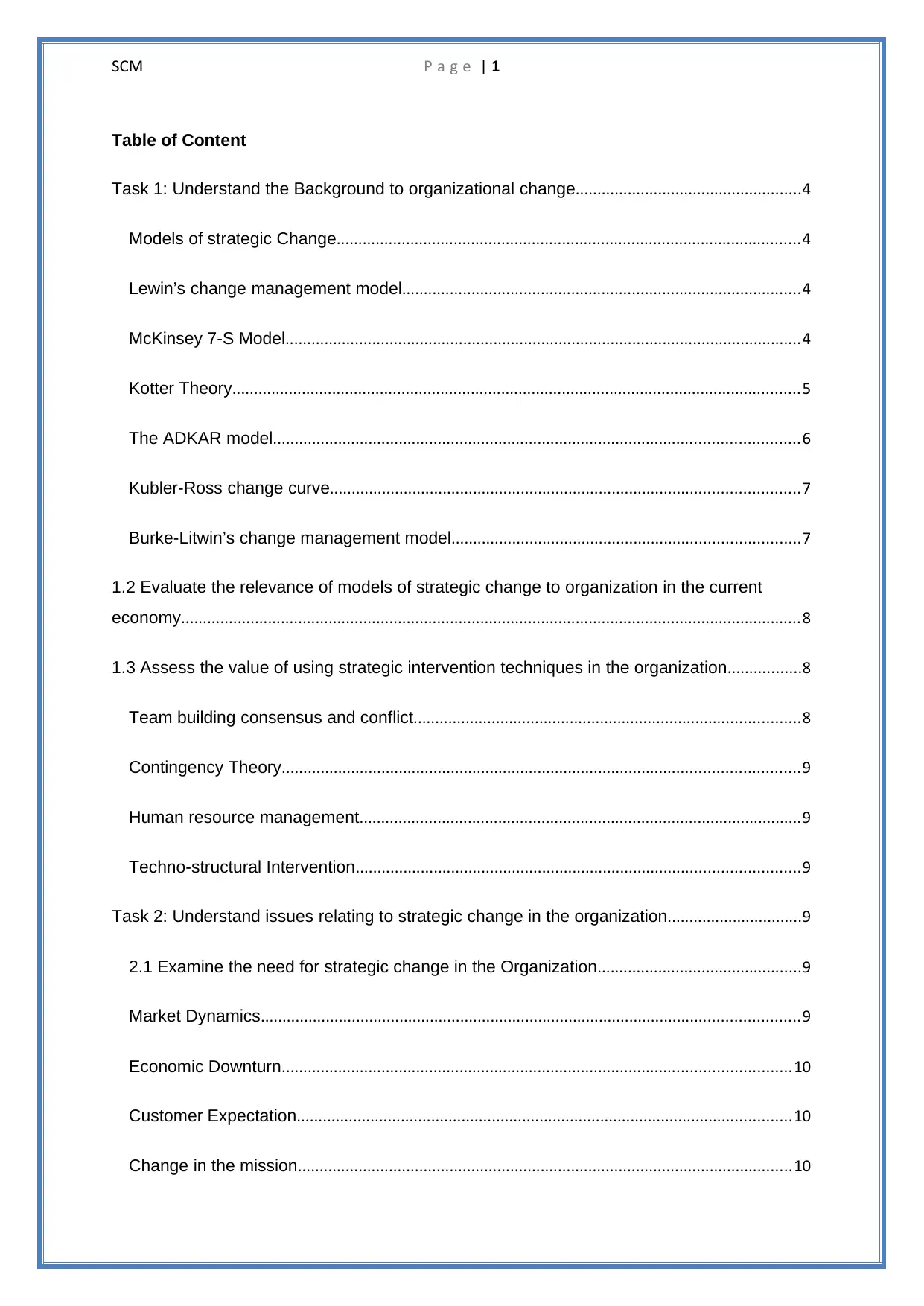
SCM P a g e | 1
Table of Content
Task 1: Understand the Background to organizational change....................................................4
Models of strategic Change...........................................................................................................4
Lewin’s change management model............................................................................................4
McKinsey 7-S Model.......................................................................................................................4
Kotter Theory...................................................................................................................................5
The ADKAR model.........................................................................................................................6
Kubler-Ross change curve............................................................................................................7
Burke-Litwin’s change management model................................................................................7
1.2 Evaluate the relevance of models of strategic change to organization in the current
economy...............................................................................................................................................8
1.3 Assess the value of using strategic intervention techniques in the organization.................8
Team building consensus and conflict.........................................................................................8
Contingency Theory.......................................................................................................................9
Human resource management......................................................................................................9
Techno-structural Intervention......................................................................................................9
Task 2: Understand issues relating to strategic change in the organization...............................9
2.1 Examine the need for strategic change in the Organization...............................................9
Market Dynamics............................................................................................................................9
Economic Downturn.....................................................................................................................10
Customer Expectation..................................................................................................................10
Change in the mission..................................................................................................................10
Table of Content
Task 1: Understand the Background to organizational change....................................................4
Models of strategic Change...........................................................................................................4
Lewin’s change management model............................................................................................4
McKinsey 7-S Model.......................................................................................................................4
Kotter Theory...................................................................................................................................5
The ADKAR model.........................................................................................................................6
Kubler-Ross change curve............................................................................................................7
Burke-Litwin’s change management model................................................................................7
1.2 Evaluate the relevance of models of strategic change to organization in the current
economy...............................................................................................................................................8
1.3 Assess the value of using strategic intervention techniques in the organization.................8
Team building consensus and conflict.........................................................................................8
Contingency Theory.......................................................................................................................9
Human resource management......................................................................................................9
Techno-structural Intervention......................................................................................................9
Task 2: Understand issues relating to strategic change in the organization...............................9
2.1 Examine the need for strategic change in the Organization...............................................9
Market Dynamics............................................................................................................................9
Economic Downturn.....................................................................................................................10
Customer Expectation..................................................................................................................10
Change in the mission..................................................................................................................10
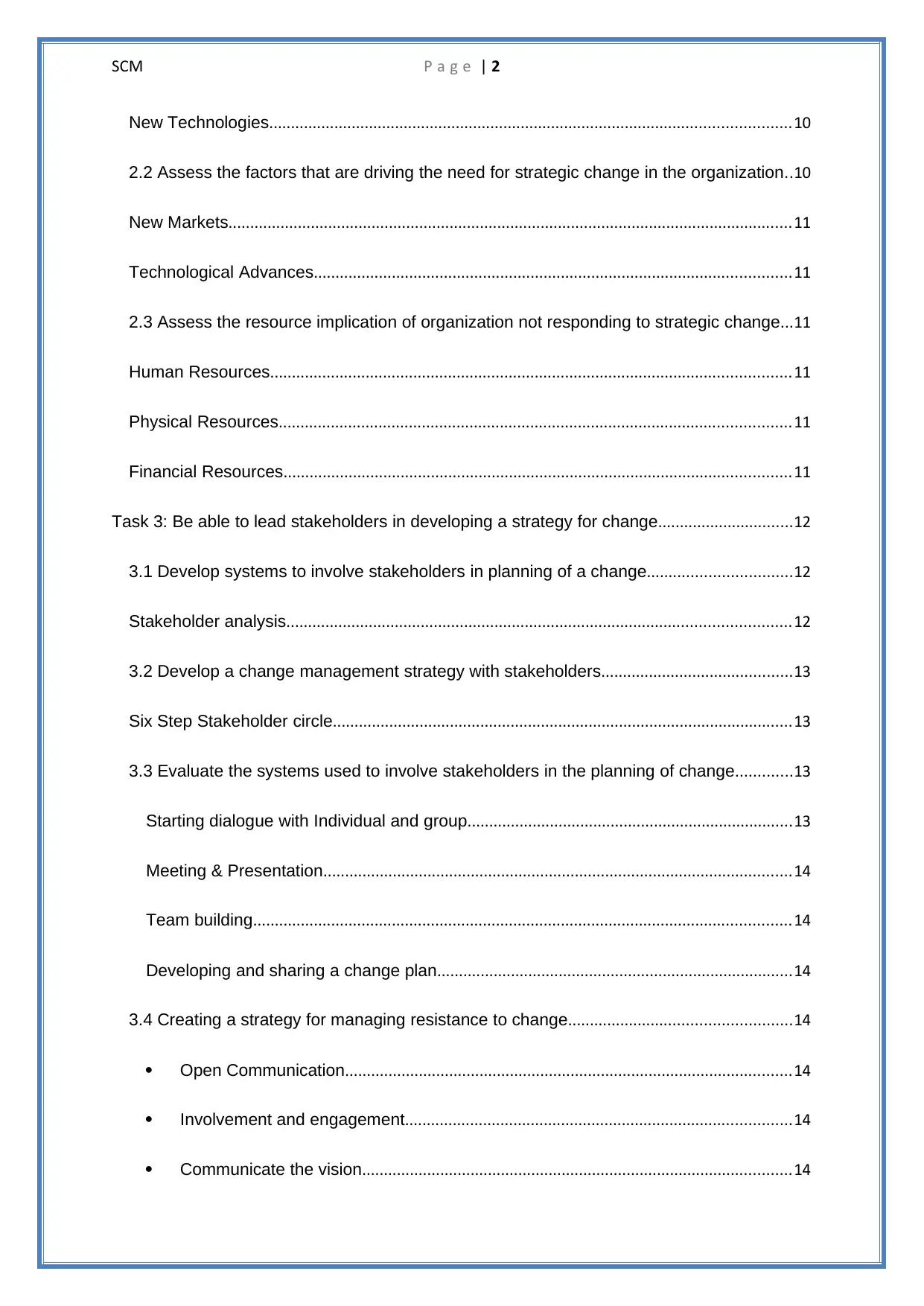
SCM P a g e | 2
New Technologies........................................................................................................................10
2.2 Assess the factors that are driving the need for strategic change in the organization..10
New Markets..................................................................................................................................11
Technological Advances..............................................................................................................11
2.3 Assess the resource implication of organization not responding to strategic change...11
Human Resources........................................................................................................................11
Physical Resources......................................................................................................................11
Financial Resources.....................................................................................................................11
Task 3: Be able to lead stakeholders in developing a strategy for change...............................12
3.1 Develop systems to involve stakeholders in planning of a change.................................12
Stakeholder analysis....................................................................................................................12
3.2 Develop a change management strategy with stakeholders............................................13
Six Step Stakeholder circle..........................................................................................................13
3.3 Evaluate the systems used to involve stakeholders in the planning of change.............13
Starting dialogue with Individual and group...........................................................................13
Meeting & Presentation............................................................................................................14
Team building............................................................................................................................14
Developing and sharing a change plan..................................................................................14
3.4 Creating a strategy for managing resistance to change...................................................14
Open Communication.......................................................................................................14
Involvement and engagement.........................................................................................14
Communicate the vision...................................................................................................14
New Technologies........................................................................................................................10
2.2 Assess the factors that are driving the need for strategic change in the organization..10
New Markets..................................................................................................................................11
Technological Advances..............................................................................................................11
2.3 Assess the resource implication of organization not responding to strategic change...11
Human Resources........................................................................................................................11
Physical Resources......................................................................................................................11
Financial Resources.....................................................................................................................11
Task 3: Be able to lead stakeholders in developing a strategy for change...............................12
3.1 Develop systems to involve stakeholders in planning of a change.................................12
Stakeholder analysis....................................................................................................................12
3.2 Develop a change management strategy with stakeholders............................................13
Six Step Stakeholder circle..........................................................................................................13
3.3 Evaluate the systems used to involve stakeholders in the planning of change.............13
Starting dialogue with Individual and group...........................................................................13
Meeting & Presentation............................................................................................................14
Team building............................................................................................................................14
Developing and sharing a change plan..................................................................................14
3.4 Creating a strategy for managing resistance to change...................................................14
Open Communication.......................................................................................................14
Involvement and engagement.........................................................................................14
Communicate the vision...................................................................................................14
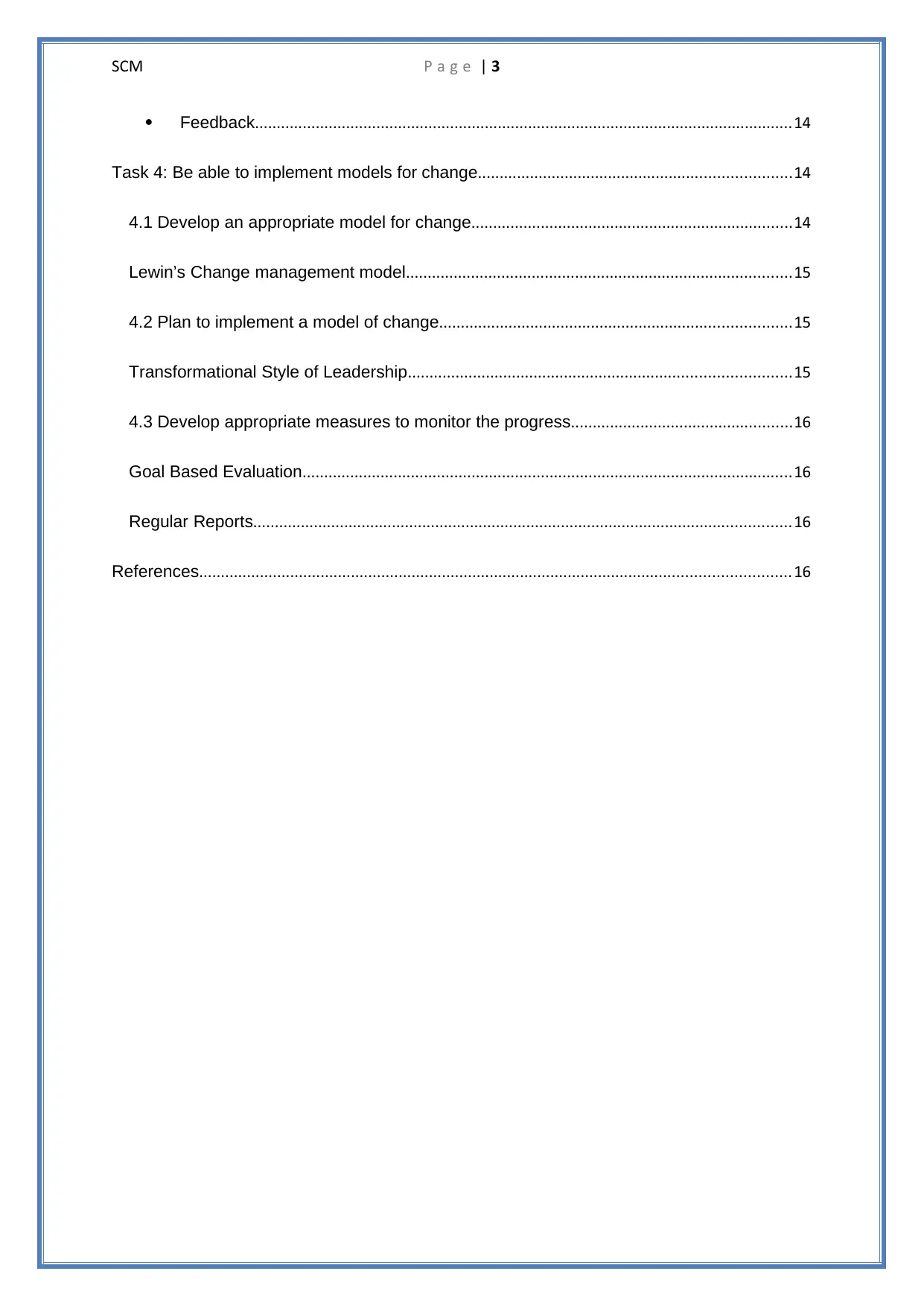
SCM P a g e | 3
Feedback............................................................................................................................14
Task 4: Be able to implement models for change........................................................................14
4.1 Develop an appropriate model for change..........................................................................14
Lewin’s Change management model.........................................................................................15
4.2 Plan to implement a model of change.................................................................................15
Transformational Style of Leadership........................................................................................15
4.3 Develop appropriate measures to monitor the progress...................................................16
Goal Based Evaluation.................................................................................................................16
Regular Reports............................................................................................................................16
References........................................................................................................................................16
Feedback............................................................................................................................14
Task 4: Be able to implement models for change........................................................................14
4.1 Develop an appropriate model for change..........................................................................14
Lewin’s Change management model.........................................................................................15
4.2 Plan to implement a model of change.................................................................................15
Transformational Style of Leadership........................................................................................15
4.3 Develop appropriate measures to monitor the progress...................................................16
Goal Based Evaluation.................................................................................................................16
Regular Reports............................................................................................................................16
References........................................................................................................................................16
Secure Best Marks with AI Grader
Need help grading? Try our AI Grader for instant feedback on your assignments.
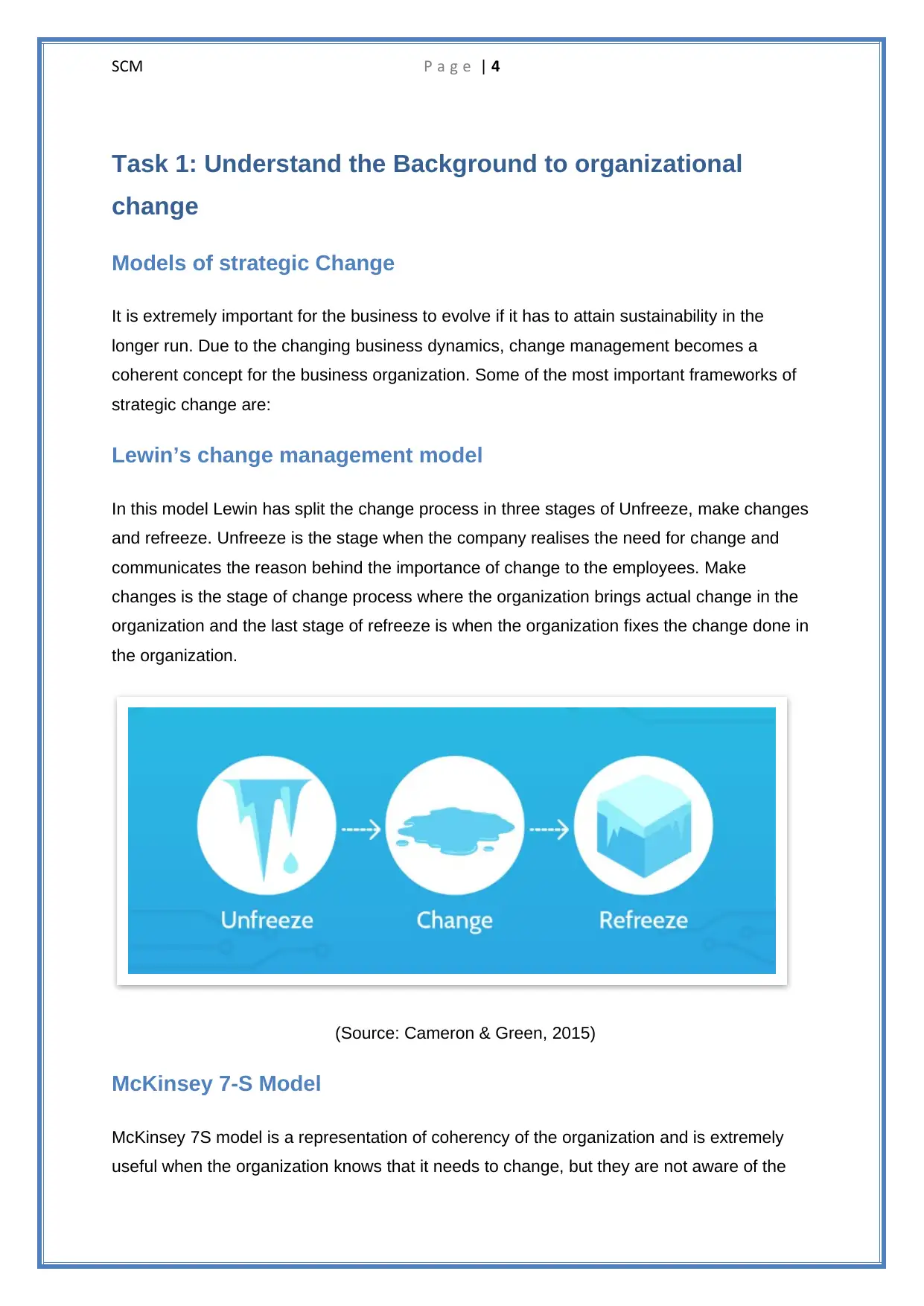
SCM P a g e | 4
Task 1: Understand the Background to organizational
change
Models of strategic Change
It is extremely important for the business to evolve if it has to attain sustainability in the
longer run. Due to the changing business dynamics, change management becomes a
coherent concept for the business organization. Some of the most important frameworks of
strategic change are:
Lewin’s change management model
In this model Lewin has split the change process in three stages of Unfreeze, make changes
and refreeze. Unfreeze is the stage when the company realises the need for change and
communicates the reason behind the importance of change to the employees. Make
changes is the stage of change process where the organization brings actual change in the
organization and the last stage of refreeze is when the organization fixes the change done in
the organization.
(Source: Cameron & Green, 2015)
McKinsey 7-S Model
McKinsey 7S model is a representation of coherency of the organization and is extremely
useful when the organization knows that it needs to change, but they are not aware of the
Task 1: Understand the Background to organizational
change
Models of strategic Change
It is extremely important for the business to evolve if it has to attain sustainability in the
longer run. Due to the changing business dynamics, change management becomes a
coherent concept for the business organization. Some of the most important frameworks of
strategic change are:
Lewin’s change management model
In this model Lewin has split the change process in three stages of Unfreeze, make changes
and refreeze. Unfreeze is the stage when the company realises the need for change and
communicates the reason behind the importance of change to the employees. Make
changes is the stage of change process where the organization brings actual change in the
organization and the last stage of refreeze is when the organization fixes the change done in
the organization.
(Source: Cameron & Green, 2015)
McKinsey 7-S Model
McKinsey 7S model is a representation of coherency of the organization and is extremely
useful when the organization knows that it needs to change, but they are not aware of the

SCM P a g e | 5
exact change dimension. Thus, analysing all the dimensions of the organization, they are
able to reach at a consensus. The areas are:
Strategy
Structure
Shared values
Style
Staff
Skills
System
(Source: Hayes, 2018)
Kotter Theory
Kotter theory has less emphasis on the change but has more emphasis on the people
behind the change. Kotter theory is capable of creating a sense of urgency in the change
management process and to maintain the momentum of the business organization to stay
steadfast on the organizational goals. The theory works according to the following:
Creation of a sense of urgency
Building a core team.
Creation of a strategic vision
Getting all the employees on board
Removing the obstacles in the path of change management
Creating milestones for short term wins
exact change dimension. Thus, analysing all the dimensions of the organization, they are
able to reach at a consensus. The areas are:
Strategy
Structure
Shared values
Style
Staff
Skills
System
(Source: Hayes, 2018)
Kotter Theory
Kotter theory has less emphasis on the change but has more emphasis on the people
behind the change. Kotter theory is capable of creating a sense of urgency in the change
management process and to maintain the momentum of the business organization to stay
steadfast on the organizational goals. The theory works according to the following:
Creation of a sense of urgency
Building a core team.
Creation of a strategic vision
Getting all the employees on board
Removing the obstacles in the path of change management
Creating milestones for short term wins
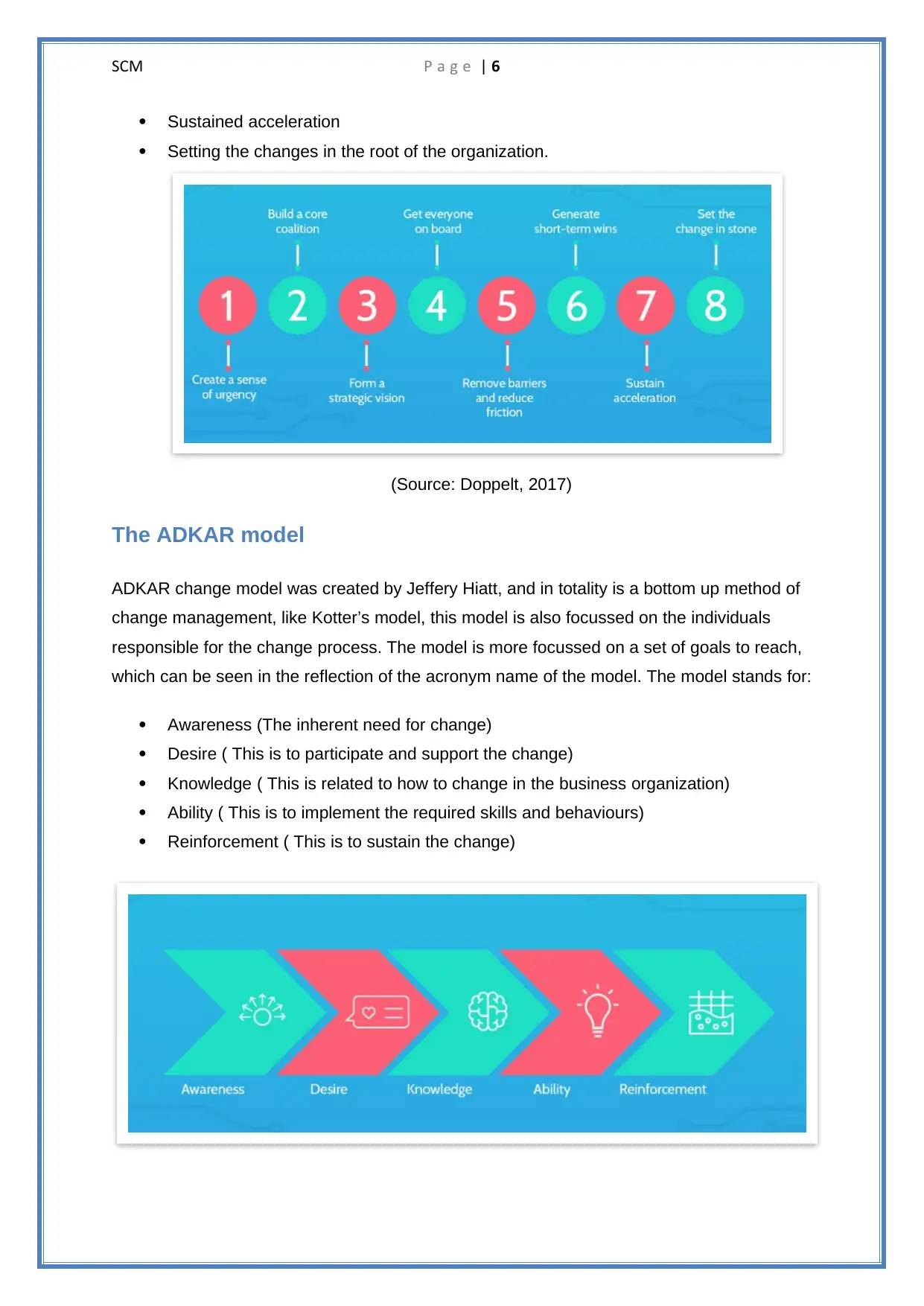
SCM P a g e | 6
Sustained acceleration
Setting the changes in the root of the organization.
(Source: Doppelt, 2017)
The ADKAR model
ADKAR change model was created by Jeffery Hiatt, and in totality is a bottom up method of
change management, like Kotter’s model, this model is also focussed on the individuals
responsible for the change process. The model is more focussed on a set of goals to reach,
which can be seen in the reflection of the acronym name of the model. The model stands for:
Awareness (The inherent need for change)
Desire ( This is to participate and support the change)
Knowledge ( This is related to how to change in the business organization)
Ability ( This is to implement the required skills and behaviours)
Reinforcement ( This is to sustain the change)
Sustained acceleration
Setting the changes in the root of the organization.
(Source: Doppelt, 2017)
The ADKAR model
ADKAR change model was created by Jeffery Hiatt, and in totality is a bottom up method of
change management, like Kotter’s model, this model is also focussed on the individuals
responsible for the change process. The model is more focussed on a set of goals to reach,
which can be seen in the reflection of the acronym name of the model. The model stands for:
Awareness (The inherent need for change)
Desire ( This is to participate and support the change)
Knowledge ( This is related to how to change in the business organization)
Ability ( This is to implement the required skills and behaviours)
Reinforcement ( This is to sustain the change)
Paraphrase This Document
Need a fresh take? Get an instant paraphrase of this document with our AI Paraphraser
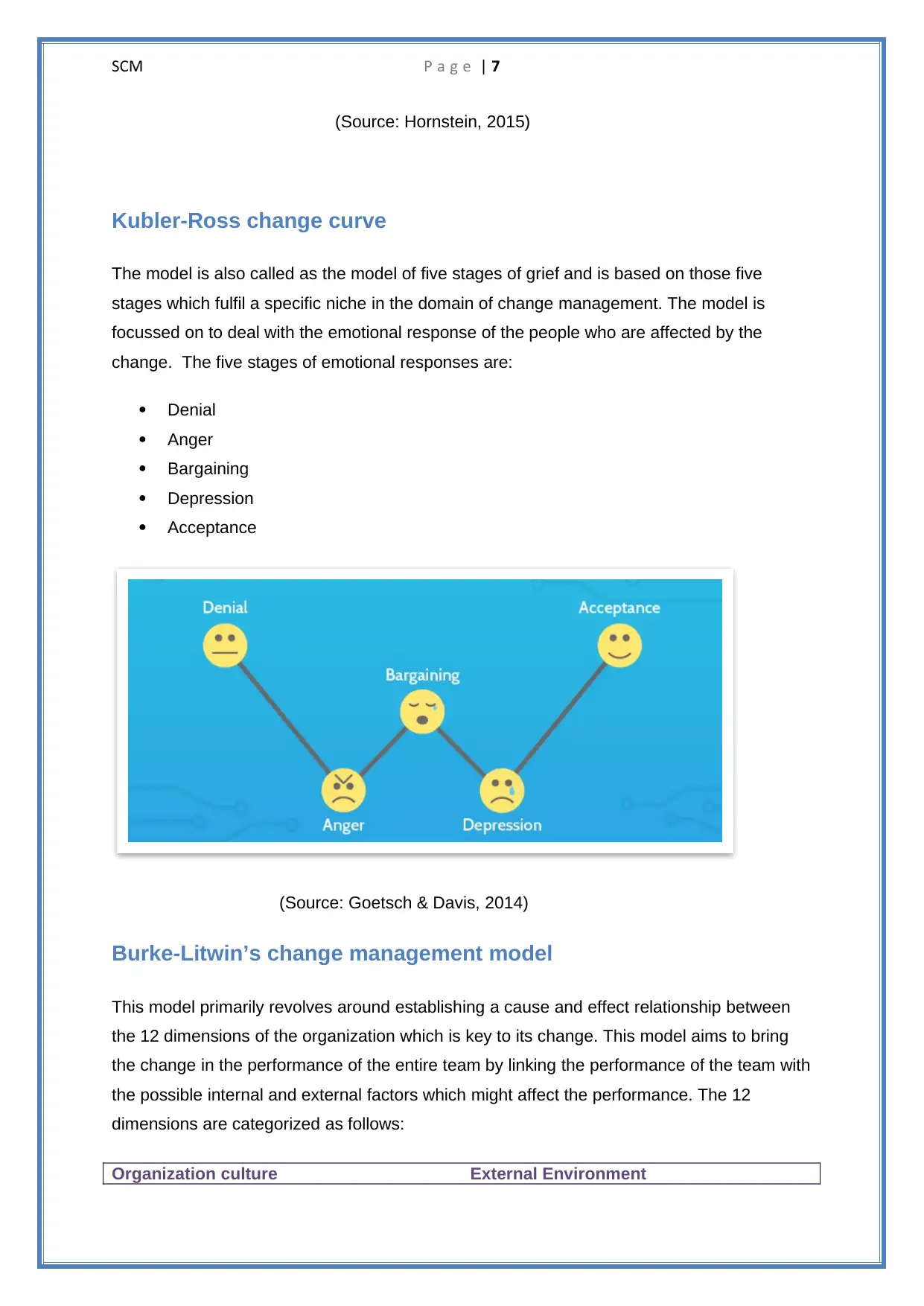
SCM P a g e | 7
(Source: Hornstein, 2015)
Kubler-Ross change curve
The model is also called as the model of five stages of grief and is based on those five
stages which fulfil a specific niche in the domain of change management. The model is
focussed on to deal with the emotional response of the people who are affected by the
change. The five stages of emotional responses are:
Denial
Anger
Bargaining
Depression
Acceptance
(Source: Goetsch & Davis, 2014)
Burke-Litwin’s change management model
This model primarily revolves around establishing a cause and effect relationship between
the 12 dimensions of the organization which is key to its change. This model aims to bring
the change in the performance of the entire team by linking the performance of the team with
the possible internal and external factors which might affect the performance. The 12
dimensions are categorized as follows:
Organization culture External Environment
(Source: Hornstein, 2015)
Kubler-Ross change curve
The model is also called as the model of five stages of grief and is based on those five
stages which fulfil a specific niche in the domain of change management. The model is
focussed on to deal with the emotional response of the people who are affected by the
change. The five stages of emotional responses are:
Denial
Anger
Bargaining
Depression
Acceptance
(Source: Goetsch & Davis, 2014)
Burke-Litwin’s change management model
This model primarily revolves around establishing a cause and effect relationship between
the 12 dimensions of the organization which is key to its change. This model aims to bring
the change in the performance of the entire team by linking the performance of the team with
the possible internal and external factors which might affect the performance. The 12
dimensions are categorized as follows:
Organization culture External Environment
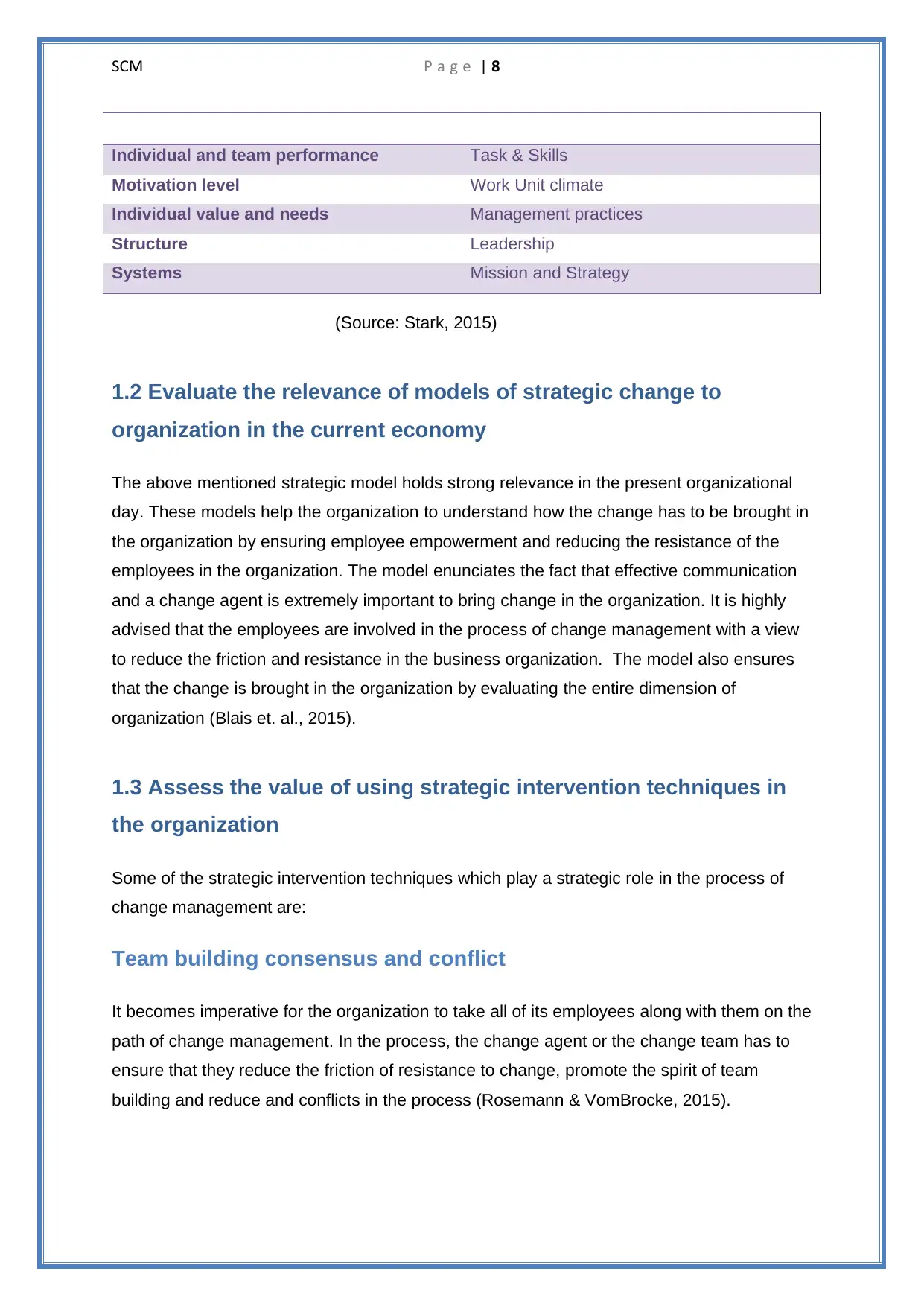
SCM P a g e | 8
Individual and team performance Task & Skills
Motivation level Work Unit climate
Individual value and needs Management practices
Structure Leadership
Systems Mission and Strategy
(Source: Stark, 2015)
1.2 Evaluate the relevance of models of strategic change to
organization in the current economy
The above mentioned strategic model holds strong relevance in the present organizational
day. These models help the organization to understand how the change has to be brought in
the organization by ensuring employee empowerment and reducing the resistance of the
employees in the organization. The model enunciates the fact that effective communication
and a change agent is extremely important to bring change in the organization. It is highly
advised that the employees are involved in the process of change management with a view
to reduce the friction and resistance in the business organization. The model also ensures
that the change is brought in the organization by evaluating the entire dimension of
organization (Blais et. al., 2015).
1.3 Assess the value of using strategic intervention techniques in
the organization
Some of the strategic intervention techniques which play a strategic role in the process of
change management are:
Team building consensus and conflict
It becomes imperative for the organization to take all of its employees along with them on the
path of change management. In the process, the change agent or the change team has to
ensure that they reduce the friction of resistance to change, promote the spirit of team
building and reduce and conflicts in the process (Rosemann & VomBrocke, 2015).
Individual and team performance Task & Skills
Motivation level Work Unit climate
Individual value and needs Management practices
Structure Leadership
Systems Mission and Strategy
(Source: Stark, 2015)
1.2 Evaluate the relevance of models of strategic change to
organization in the current economy
The above mentioned strategic model holds strong relevance in the present organizational
day. These models help the organization to understand how the change has to be brought in
the organization by ensuring employee empowerment and reducing the resistance of the
employees in the organization. The model enunciates the fact that effective communication
and a change agent is extremely important to bring change in the organization. It is highly
advised that the employees are involved in the process of change management with a view
to reduce the friction and resistance in the business organization. The model also ensures
that the change is brought in the organization by evaluating the entire dimension of
organization (Blais et. al., 2015).
1.3 Assess the value of using strategic intervention techniques in
the organization
Some of the strategic intervention techniques which play a strategic role in the process of
change management are:
Team building consensus and conflict
It becomes imperative for the organization to take all of its employees along with them on the
path of change management. In the process, the change agent or the change team has to
ensure that they reduce the friction of resistance to change, promote the spirit of team
building and reduce and conflicts in the process (Rosemann & VomBrocke, 2015).
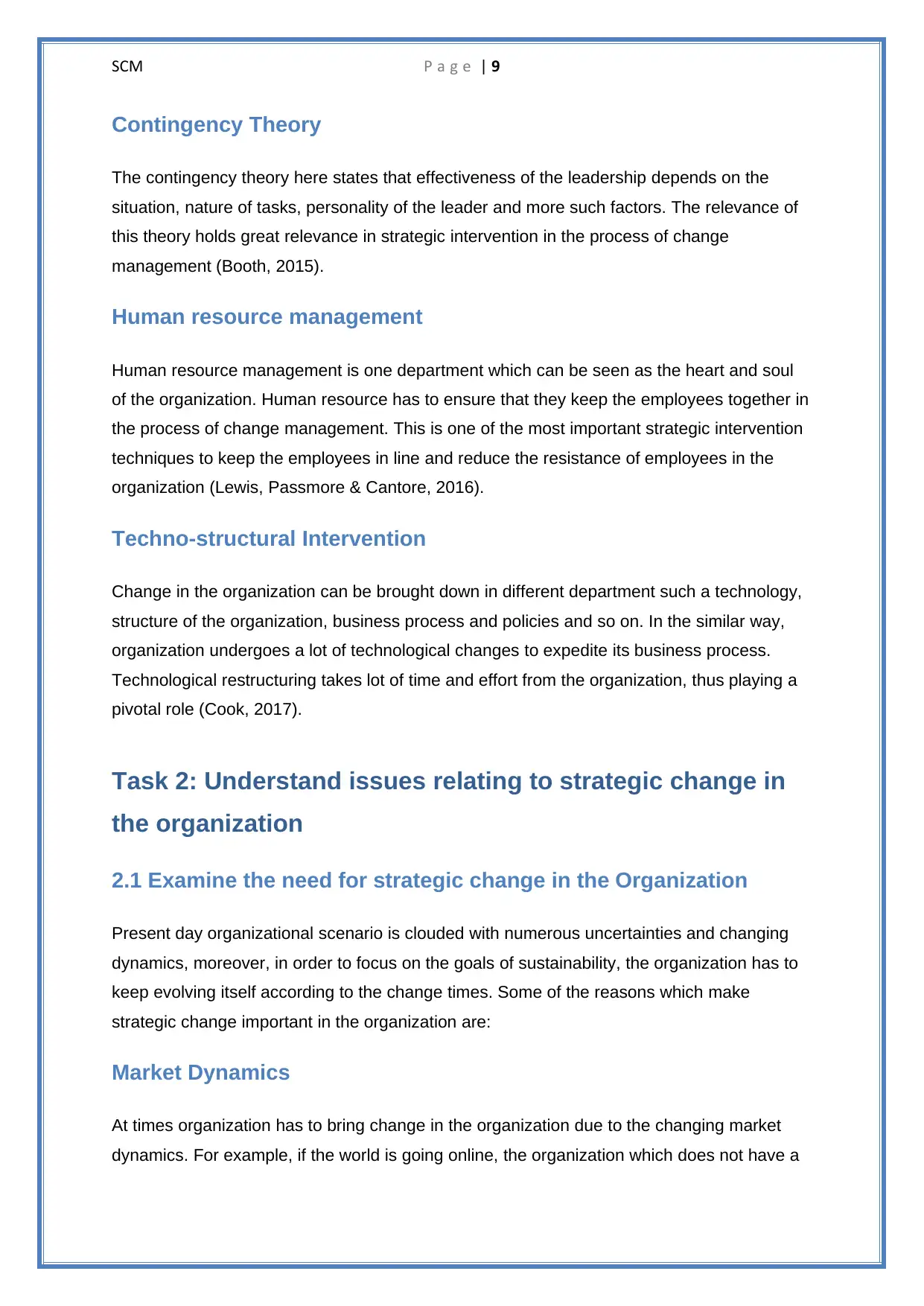
SCM P a g e | 9
Contingency Theory
The contingency theory here states that effectiveness of the leadership depends on the
situation, nature of tasks, personality of the leader and more such factors. The relevance of
this theory holds great relevance in strategic intervention in the process of change
management (Booth, 2015).
Human resource management
Human resource management is one department which can be seen as the heart and soul
of the organization. Human resource has to ensure that they keep the employees together in
the process of change management. This is one of the most important strategic intervention
techniques to keep the employees in line and reduce the resistance of employees in the
organization (Lewis, Passmore & Cantore, 2016).
Techno-structural Intervention
Change in the organization can be brought down in different department such a technology,
structure of the organization, business process and policies and so on. In the similar way,
organization undergoes a lot of technological changes to expedite its business process.
Technological restructuring takes lot of time and effort from the organization, thus playing a
pivotal role (Cook, 2017).
Task 2: Understand issues relating to strategic change in
the organization
2.1 Examine the need for strategic change in the Organization
Present day organizational scenario is clouded with numerous uncertainties and changing
dynamics, moreover, in order to focus on the goals of sustainability, the organization has to
keep evolving itself according to the change times. Some of the reasons which make
strategic change important in the organization are:
Market Dynamics
At times organization has to bring change in the organization due to the changing market
dynamics. For example, if the world is going online, the organization which does not have a
Contingency Theory
The contingency theory here states that effectiveness of the leadership depends on the
situation, nature of tasks, personality of the leader and more such factors. The relevance of
this theory holds great relevance in strategic intervention in the process of change
management (Booth, 2015).
Human resource management
Human resource management is one department which can be seen as the heart and soul
of the organization. Human resource has to ensure that they keep the employees together in
the process of change management. This is one of the most important strategic intervention
techniques to keep the employees in line and reduce the resistance of employees in the
organization (Lewis, Passmore & Cantore, 2016).
Techno-structural Intervention
Change in the organization can be brought down in different department such a technology,
structure of the organization, business process and policies and so on. In the similar way,
organization undergoes a lot of technological changes to expedite its business process.
Technological restructuring takes lot of time and effort from the organization, thus playing a
pivotal role (Cook, 2017).
Task 2: Understand issues relating to strategic change in
the organization
2.1 Examine the need for strategic change in the Organization
Present day organizational scenario is clouded with numerous uncertainties and changing
dynamics, moreover, in order to focus on the goals of sustainability, the organization has to
keep evolving itself according to the change times. Some of the reasons which make
strategic change important in the organization are:
Market Dynamics
At times organization has to bring change in the organization due to the changing market
dynamics. For example, if the world is going online, the organization which does not have a
Secure Best Marks with AI Grader
Need help grading? Try our AI Grader for instant feedback on your assignments.
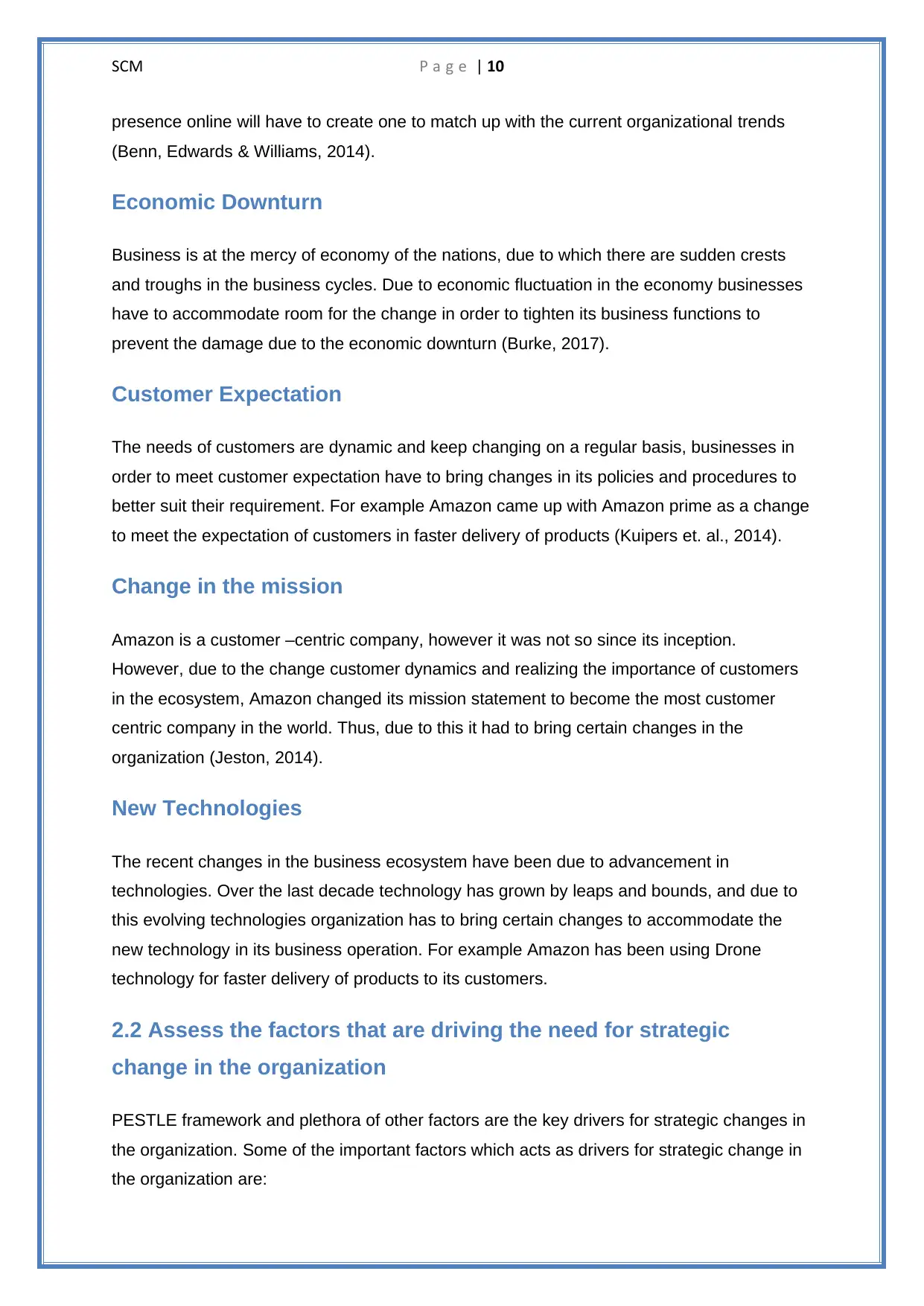
SCM P a g e | 10
presence online will have to create one to match up with the current organizational trends
(Benn, Edwards & Williams, 2014).
Economic Downturn
Business is at the mercy of economy of the nations, due to which there are sudden crests
and troughs in the business cycles. Due to economic fluctuation in the economy businesses
have to accommodate room for the change in order to tighten its business functions to
prevent the damage due to the economic downturn (Burke, 2017).
Customer Expectation
The needs of customers are dynamic and keep changing on a regular basis, businesses in
order to meet customer expectation have to bring changes in its policies and procedures to
better suit their requirement. For example Amazon came up with Amazon prime as a change
to meet the expectation of customers in faster delivery of products (Kuipers et. al., 2014).
Change in the mission
Amazon is a customer –centric company, however it was not so since its inception.
However, due to the change customer dynamics and realizing the importance of customers
in the ecosystem, Amazon changed its mission statement to become the most customer
centric company in the world. Thus, due to this it had to bring certain changes in the
organization (Jeston, 2014).
New Technologies
The recent changes in the business ecosystem have been due to advancement in
technologies. Over the last decade technology has grown by leaps and bounds, and due to
this evolving technologies organization has to bring certain changes to accommodate the
new technology in its business operation. For example Amazon has been using Drone
technology for faster delivery of products to its customers.
2.2 Assess the factors that are driving the need for strategic
change in the organization
PESTLE framework and plethora of other factors are the key drivers for strategic changes in
the organization. Some of the important factors which acts as drivers for strategic change in
the organization are:
presence online will have to create one to match up with the current organizational trends
(Benn, Edwards & Williams, 2014).
Economic Downturn
Business is at the mercy of economy of the nations, due to which there are sudden crests
and troughs in the business cycles. Due to economic fluctuation in the economy businesses
have to accommodate room for the change in order to tighten its business functions to
prevent the damage due to the economic downturn (Burke, 2017).
Customer Expectation
The needs of customers are dynamic and keep changing on a regular basis, businesses in
order to meet customer expectation have to bring changes in its policies and procedures to
better suit their requirement. For example Amazon came up with Amazon prime as a change
to meet the expectation of customers in faster delivery of products (Kuipers et. al., 2014).
Change in the mission
Amazon is a customer –centric company, however it was not so since its inception.
However, due to the change customer dynamics and realizing the importance of customers
in the ecosystem, Amazon changed its mission statement to become the most customer
centric company in the world. Thus, due to this it had to bring certain changes in the
organization (Jeston, 2014).
New Technologies
The recent changes in the business ecosystem have been due to advancement in
technologies. Over the last decade technology has grown by leaps and bounds, and due to
this evolving technologies organization has to bring certain changes to accommodate the
new technology in its business operation. For example Amazon has been using Drone
technology for faster delivery of products to its customers.
2.2 Assess the factors that are driving the need for strategic
change in the organization
PESTLE framework and plethora of other factors are the key drivers for strategic changes in
the organization. Some of the important factors which acts as drivers for strategic change in
the organization are:
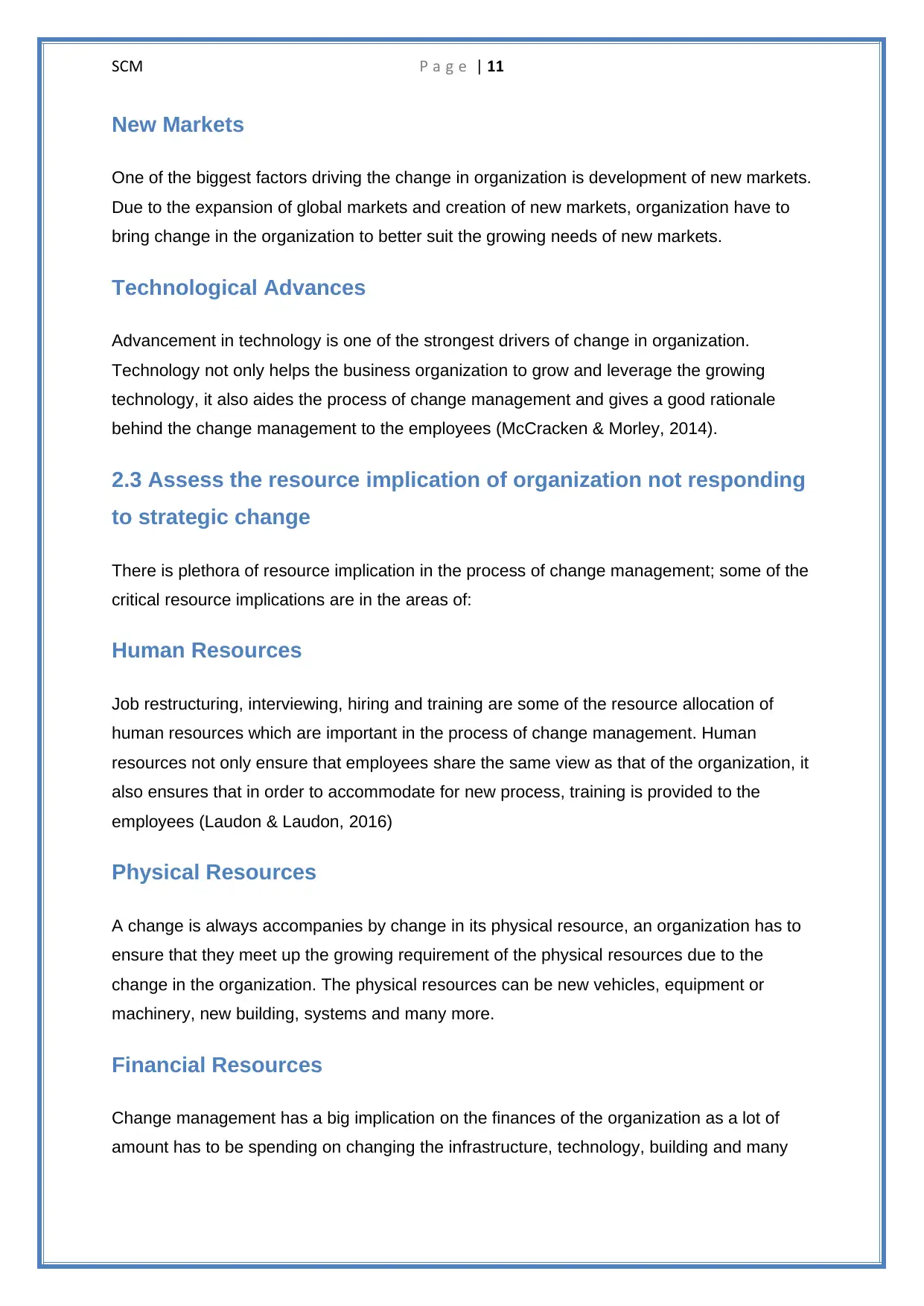
SCM P a g e | 11
New Markets
One of the biggest factors driving the change in organization is development of new markets.
Due to the expansion of global markets and creation of new markets, organization have to
bring change in the organization to better suit the growing needs of new markets.
Technological Advances
Advancement in technology is one of the strongest drivers of change in organization.
Technology not only helps the business organization to grow and leverage the growing
technology, it also aides the process of change management and gives a good rationale
behind the change management to the employees (McCracken & Morley, 2014).
2.3 Assess the resource implication of organization not responding
to strategic change
There is plethora of resource implication in the process of change management; some of the
critical resource implications are in the areas of:
Human Resources
Job restructuring, interviewing, hiring and training are some of the resource allocation of
human resources which are important in the process of change management. Human
resources not only ensure that employees share the same view as that of the organization, it
also ensures that in order to accommodate for new process, training is provided to the
employees (Laudon & Laudon, 2016)
Physical Resources
A change is always accompanies by change in its physical resource, an organization has to
ensure that they meet up the growing requirement of the physical resources due to the
change in the organization. The physical resources can be new vehicles, equipment or
machinery, new building, systems and many more.
Financial Resources
Change management has a big implication on the finances of the organization as a lot of
amount has to be spending on changing the infrastructure, technology, building and many
New Markets
One of the biggest factors driving the change in organization is development of new markets.
Due to the expansion of global markets and creation of new markets, organization have to
bring change in the organization to better suit the growing needs of new markets.
Technological Advances
Advancement in technology is one of the strongest drivers of change in organization.
Technology not only helps the business organization to grow and leverage the growing
technology, it also aides the process of change management and gives a good rationale
behind the change management to the employees (McCracken & Morley, 2014).
2.3 Assess the resource implication of organization not responding
to strategic change
There is plethora of resource implication in the process of change management; some of the
critical resource implications are in the areas of:
Human Resources
Job restructuring, interviewing, hiring and training are some of the resource allocation of
human resources which are important in the process of change management. Human
resources not only ensure that employees share the same view as that of the organization, it
also ensures that in order to accommodate for new process, training is provided to the
employees (Laudon & Laudon, 2016)
Physical Resources
A change is always accompanies by change in its physical resource, an organization has to
ensure that they meet up the growing requirement of the physical resources due to the
change in the organization. The physical resources can be new vehicles, equipment or
machinery, new building, systems and many more.
Financial Resources
Change management has a big implication on the finances of the organization as a lot of
amount has to be spending on changing the infrastructure, technology, building and many
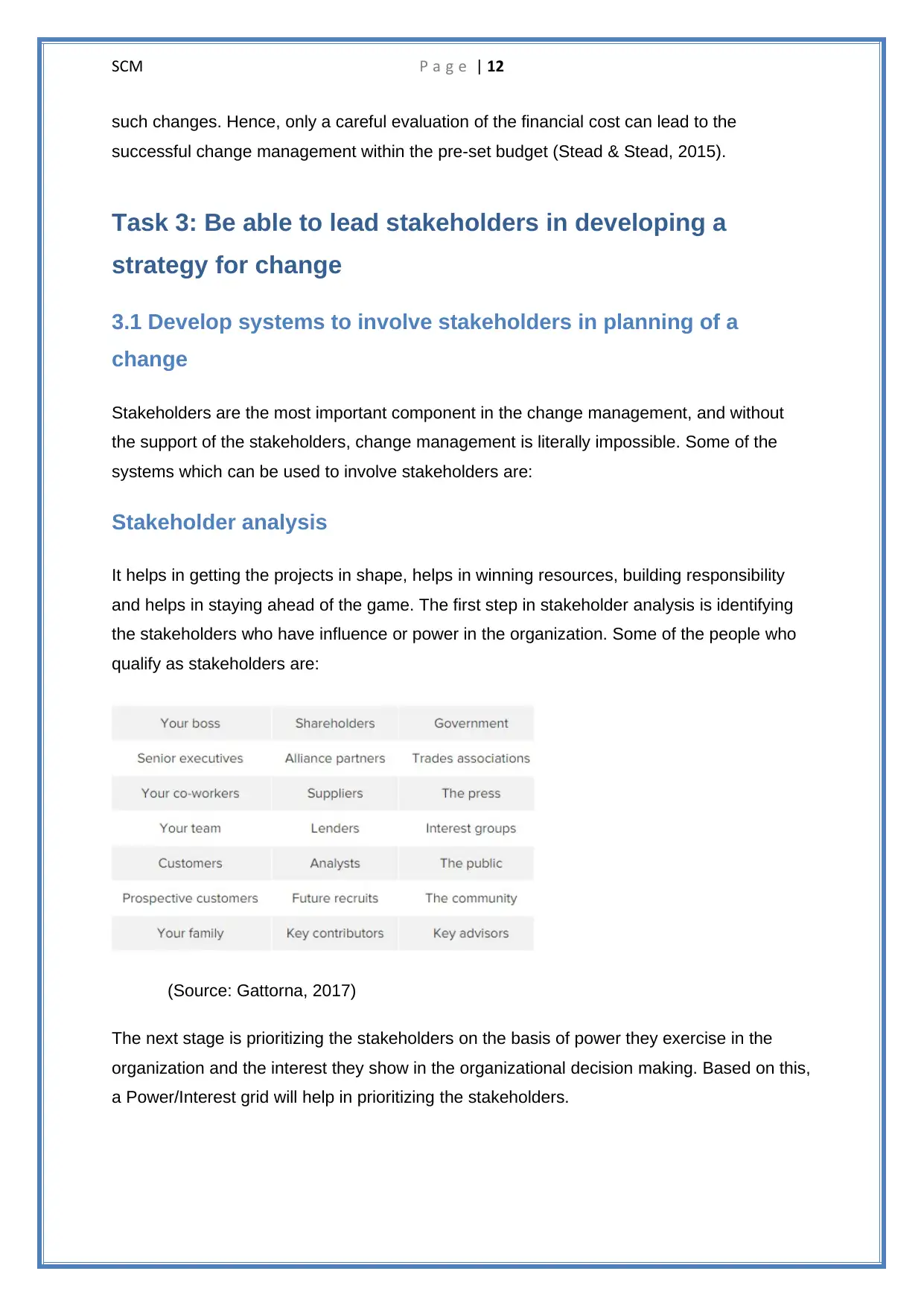
SCM P a g e | 12
such changes. Hence, only a careful evaluation of the financial cost can lead to the
successful change management within the pre-set budget (Stead & Stead, 2015).
Task 3: Be able to lead stakeholders in developing a
strategy for change
3.1 Develop systems to involve stakeholders in planning of a
change
Stakeholders are the most important component in the change management, and without
the support of the stakeholders, change management is literally impossible. Some of the
systems which can be used to involve stakeholders are:
Stakeholder analysis
It helps in getting the projects in shape, helps in winning resources, building responsibility
and helps in staying ahead of the game. The first step in stakeholder analysis is identifying
the stakeholders who have influence or power in the organization. Some of the people who
qualify as stakeholders are:
(Source: Gattorna, 2017)
The next stage is prioritizing the stakeholders on the basis of power they exercise in the
organization and the interest they show in the organizational decision making. Based on this,
a Power/Interest grid will help in prioritizing the stakeholders.
such changes. Hence, only a careful evaluation of the financial cost can lead to the
successful change management within the pre-set budget (Stead & Stead, 2015).
Task 3: Be able to lead stakeholders in developing a
strategy for change
3.1 Develop systems to involve stakeholders in planning of a
change
Stakeholders are the most important component in the change management, and without
the support of the stakeholders, change management is literally impossible. Some of the
systems which can be used to involve stakeholders are:
Stakeholder analysis
It helps in getting the projects in shape, helps in winning resources, building responsibility
and helps in staying ahead of the game. The first step in stakeholder analysis is identifying
the stakeholders who have influence or power in the organization. Some of the people who
qualify as stakeholders are:
(Source: Gattorna, 2017)
The next stage is prioritizing the stakeholders on the basis of power they exercise in the
organization and the interest they show in the organizational decision making. Based on this,
a Power/Interest grid will help in prioritizing the stakeholders.
Paraphrase This Document
Need a fresh take? Get an instant paraphrase of this document with our AI Paraphraser
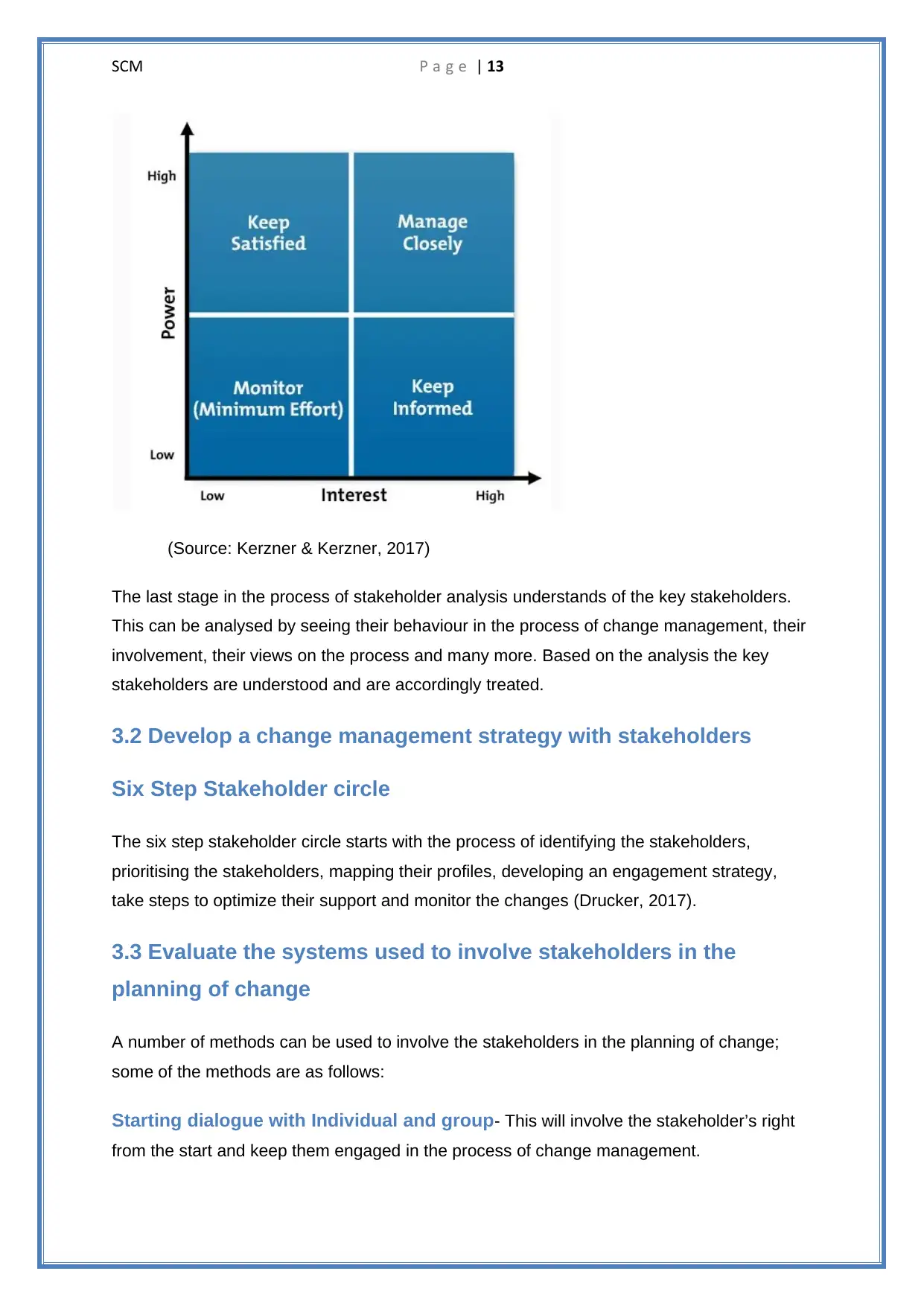
SCM P a g e | 13
(Source: Kerzner & Kerzner, 2017)
The last stage in the process of stakeholder analysis understands of the key stakeholders.
This can be analysed by seeing their behaviour in the process of change management, their
involvement, their views on the process and many more. Based on the analysis the key
stakeholders are understood and are accordingly treated.
3.2 Develop a change management strategy with stakeholders
Six Step Stakeholder circle
The six step stakeholder circle starts with the process of identifying the stakeholders,
prioritising the stakeholders, mapping their profiles, developing an engagement strategy,
take steps to optimize their support and monitor the changes (Drucker, 2017).
3.3 Evaluate the systems used to involve stakeholders in the
planning of change
A number of methods can be used to involve the stakeholders in the planning of change;
some of the methods are as follows:
Starting dialogue with Individual and group- This will involve the stakeholder’s right
from the start and keep them engaged in the process of change management.
(Source: Kerzner & Kerzner, 2017)
The last stage in the process of stakeholder analysis understands of the key stakeholders.
This can be analysed by seeing their behaviour in the process of change management, their
involvement, their views on the process and many more. Based on the analysis the key
stakeholders are understood and are accordingly treated.
3.2 Develop a change management strategy with stakeholders
Six Step Stakeholder circle
The six step stakeholder circle starts with the process of identifying the stakeholders,
prioritising the stakeholders, mapping their profiles, developing an engagement strategy,
take steps to optimize their support and monitor the changes (Drucker, 2017).
3.3 Evaluate the systems used to involve stakeholders in the
planning of change
A number of methods can be used to involve the stakeholders in the planning of change;
some of the methods are as follows:
Starting dialogue with Individual and group- This will involve the stakeholder’s right
from the start and keep them engaged in the process of change management.
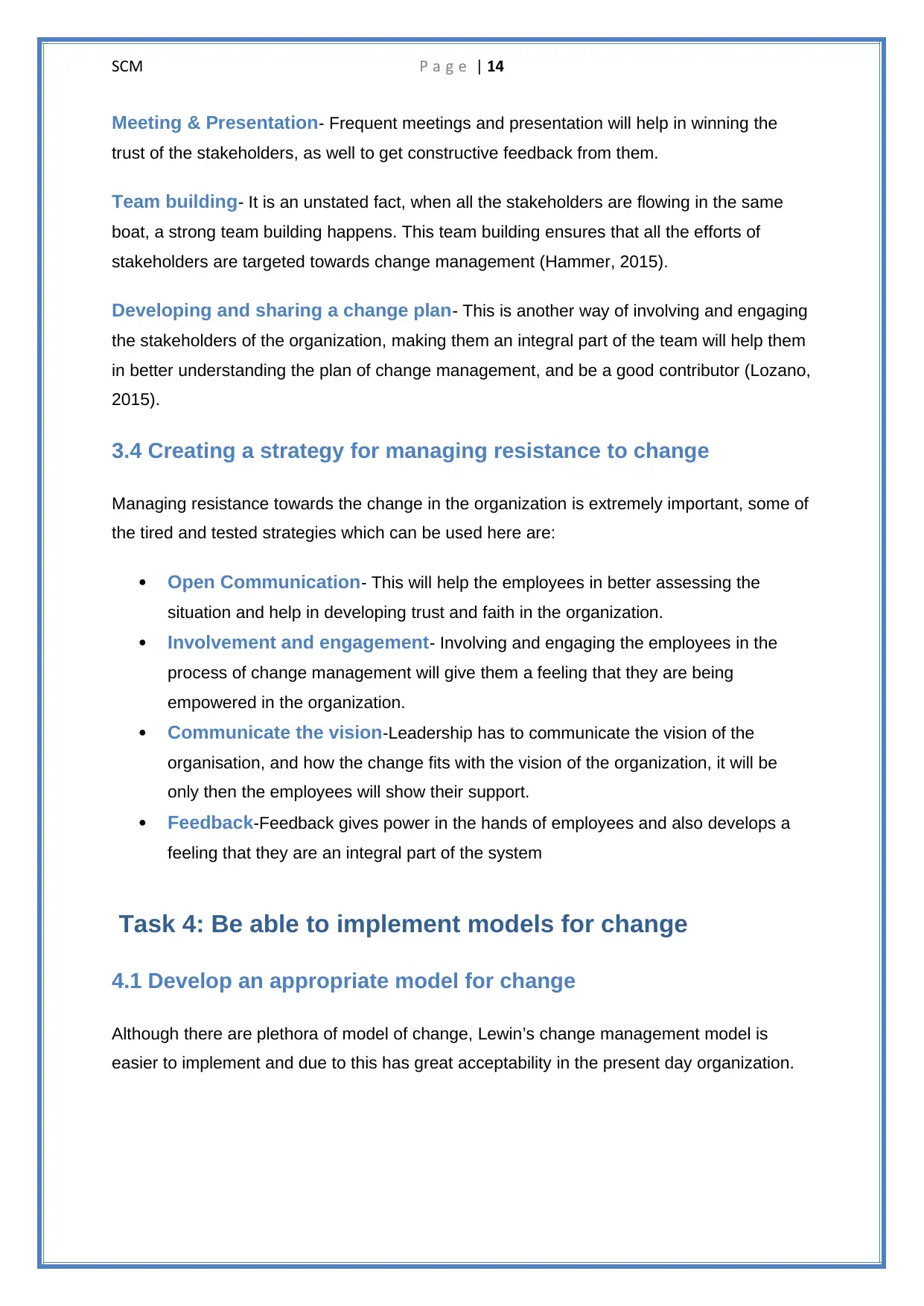
SCM P a g e | 14
Meeting & Presentation- Frequent meetings and presentation will help in winning the
trust of the stakeholders, as well to get constructive feedback from them.
Team building- It is an unstated fact, when all the stakeholders are flowing in the same
boat, a strong team building happens. This team building ensures that all the efforts of
stakeholders are targeted towards change management (Hammer, 2015).
Developing and sharing a change plan- This is another way of involving and engaging
the stakeholders of the organization, making them an integral part of the team will help them
in better understanding the plan of change management, and be a good contributor (Lozano,
2015).
3.4 Creating a strategy for managing resistance to change
Managing resistance towards the change in the organization is extremely important, some of
the tired and tested strategies which can be used here are:
Open Communication- This will help the employees in better assessing the
situation and help in developing trust and faith in the organization.
Involvement and engagement- Involving and engaging the employees in the
process of change management will give them a feeling that they are being
empowered in the organization.
Communicate the vision-Leadership has to communicate the vision of the
organisation, and how the change fits with the vision of the organization, it will be
only then the employees will show their support.
Feedback-Feedback gives power in the hands of employees and also develops a
feeling that they are an integral part of the system
Task 4: Be able to implement models for change
4.1 Develop an appropriate model for change
Although there are plethora of model of change, Lewin’s change management model is
easier to implement and due to this has great acceptability in the present day organization.
Meeting & Presentation- Frequent meetings and presentation will help in winning the
trust of the stakeholders, as well to get constructive feedback from them.
Team building- It is an unstated fact, when all the stakeholders are flowing in the same
boat, a strong team building happens. This team building ensures that all the efforts of
stakeholders are targeted towards change management (Hammer, 2015).
Developing and sharing a change plan- This is another way of involving and engaging
the stakeholders of the organization, making them an integral part of the team will help them
in better understanding the plan of change management, and be a good contributor (Lozano,
2015).
3.4 Creating a strategy for managing resistance to change
Managing resistance towards the change in the organization is extremely important, some of
the tired and tested strategies which can be used here are:
Open Communication- This will help the employees in better assessing the
situation and help in developing trust and faith in the organization.
Involvement and engagement- Involving and engaging the employees in the
process of change management will give them a feeling that they are being
empowered in the organization.
Communicate the vision-Leadership has to communicate the vision of the
organisation, and how the change fits with the vision of the organization, it will be
only then the employees will show their support.
Feedback-Feedback gives power in the hands of employees and also develops a
feeling that they are an integral part of the system
Task 4: Be able to implement models for change
4.1 Develop an appropriate model for change
Although there are plethora of model of change, Lewin’s change management model is
easier to implement and due to this has great acceptability in the present day organization.
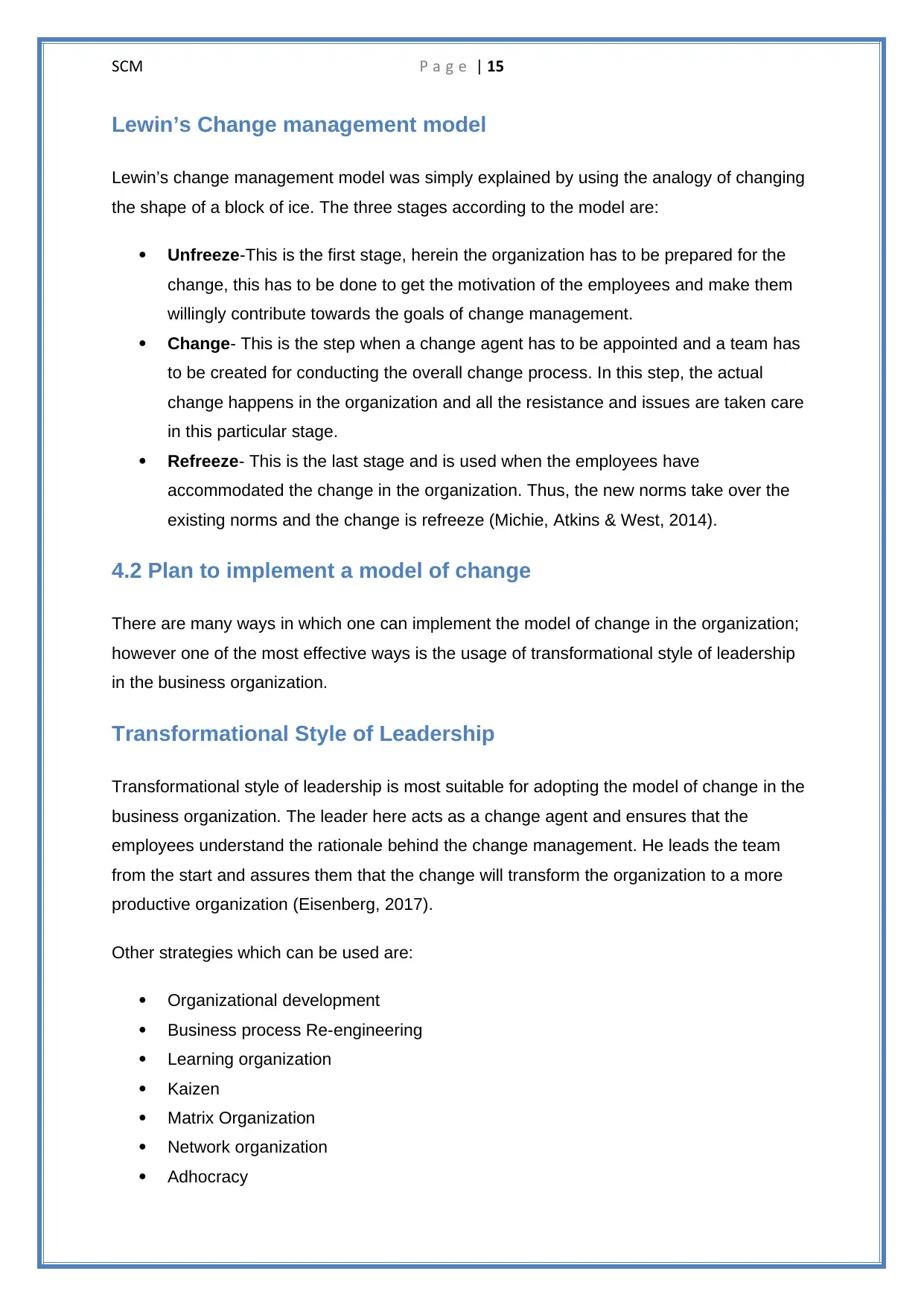
SCM P a g e | 15
Lewin’s Change management model
Lewin’s change management model was simply explained by using the analogy of changing
the shape of a block of ice. The three stages according to the model are:
Unfreeze-This is the first stage, herein the organization has to be prepared for the
change, this has to be done to get the motivation of the employees and make them
willingly contribute towards the goals of change management.
Change- This is the step when a change agent has to be appointed and a team has
to be created for conducting the overall change process. In this step, the actual
change happens in the organization and all the resistance and issues are taken care
in this particular stage.
Refreeze- This is the last stage and is used when the employees have
accommodated the change in the organization. Thus, the new norms take over the
existing norms and the change is refreeze (Michie, Atkins & West, 2014).
4.2 Plan to implement a model of change
There are many ways in which one can implement the model of change in the organization;
however one of the most effective ways is the usage of transformational style of leadership
in the business organization.
Transformational Style of Leadership
Transformational style of leadership is most suitable for adopting the model of change in the
business organization. The leader here acts as a change agent and ensures that the
employees understand the rationale behind the change management. He leads the team
from the start and assures them that the change will transform the organization to a more
productive organization (Eisenberg, 2017).
Other strategies which can be used are:
Organizational development
Business process Re-engineering
Learning organization
Kaizen
Matrix Organization
Network organization
Adhocracy
Lewin’s Change management model
Lewin’s change management model was simply explained by using the analogy of changing
the shape of a block of ice. The three stages according to the model are:
Unfreeze-This is the first stage, herein the organization has to be prepared for the
change, this has to be done to get the motivation of the employees and make them
willingly contribute towards the goals of change management.
Change- This is the step when a change agent has to be appointed and a team has
to be created for conducting the overall change process. In this step, the actual
change happens in the organization and all the resistance and issues are taken care
in this particular stage.
Refreeze- This is the last stage and is used when the employees have
accommodated the change in the organization. Thus, the new norms take over the
existing norms and the change is refreeze (Michie, Atkins & West, 2014).
4.2 Plan to implement a model of change
There are many ways in which one can implement the model of change in the organization;
however one of the most effective ways is the usage of transformational style of leadership
in the business organization.
Transformational Style of Leadership
Transformational style of leadership is most suitable for adopting the model of change in the
business organization. The leader here acts as a change agent and ensures that the
employees understand the rationale behind the change management. He leads the team
from the start and assures them that the change will transform the organization to a more
productive organization (Eisenberg, 2017).
Other strategies which can be used are:
Organizational development
Business process Re-engineering
Learning organization
Kaizen
Matrix Organization
Network organization
Adhocracy
Secure Best Marks with AI Grader
Need help grading? Try our AI Grader for instant feedback on your assignments.
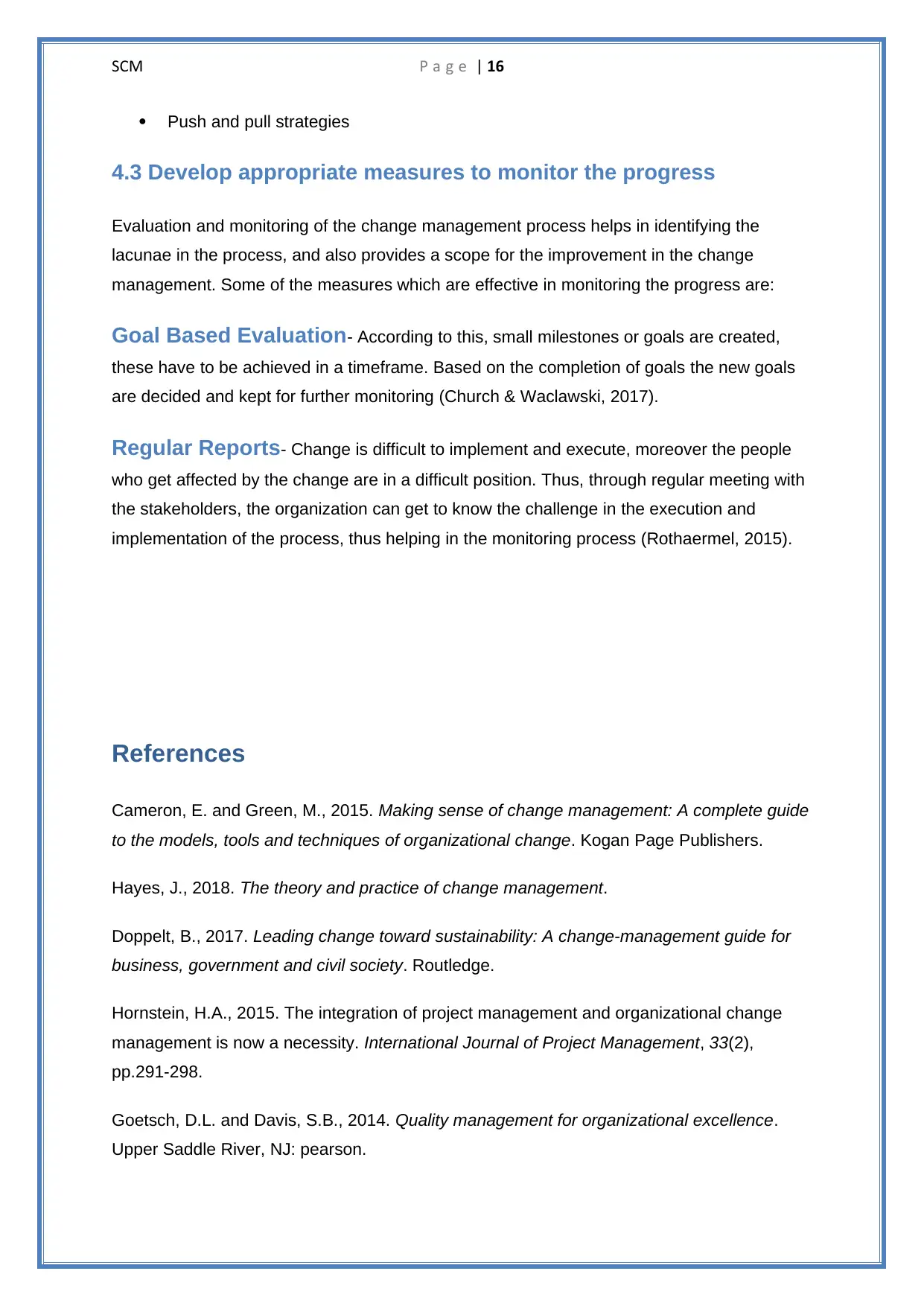
SCM P a g e | 16
Push and pull strategies
4.3 Develop appropriate measures to monitor the progress
Evaluation and monitoring of the change management process helps in identifying the
lacunae in the process, and also provides a scope for the improvement in the change
management. Some of the measures which are effective in monitoring the progress are:
Goal Based Evaluation- According to this, small milestones or goals are created,
these have to be achieved in a timeframe. Based on the completion of goals the new goals
are decided and kept for further monitoring (Church & Waclawski, 2017).
Regular Reports- Change is difficult to implement and execute, moreover the people
who get affected by the change are in a difficult position. Thus, through regular meeting with
the stakeholders, the organization can get to know the challenge in the execution and
implementation of the process, thus helping in the monitoring process (Rothaermel, 2015).
References
Cameron, E. and Green, M., 2015. Making sense of change management: A complete guide
to the models, tools and techniques of organizational change. Kogan Page Publishers.
Hayes, J., 2018. The theory and practice of change management.
Doppelt, B., 2017. Leading change toward sustainability: A change-management guide for
business, government and civil society. Routledge.
Hornstein, H.A., 2015. The integration of project management and organizational change
management is now a necessity. International Journal of Project Management, 33(2),
pp.291-298.
Goetsch, D.L. and Davis, S.B., 2014. Quality management for organizational excellence.
Upper Saddle River, NJ: pearson.
Push and pull strategies
4.3 Develop appropriate measures to monitor the progress
Evaluation and monitoring of the change management process helps in identifying the
lacunae in the process, and also provides a scope for the improvement in the change
management. Some of the measures which are effective in monitoring the progress are:
Goal Based Evaluation- According to this, small milestones or goals are created,
these have to be achieved in a timeframe. Based on the completion of goals the new goals
are decided and kept for further monitoring (Church & Waclawski, 2017).
Regular Reports- Change is difficult to implement and execute, moreover the people
who get affected by the change are in a difficult position. Thus, through regular meeting with
the stakeholders, the organization can get to know the challenge in the execution and
implementation of the process, thus helping in the monitoring process (Rothaermel, 2015).
References
Cameron, E. and Green, M., 2015. Making sense of change management: A complete guide
to the models, tools and techniques of organizational change. Kogan Page Publishers.
Hayes, J., 2018. The theory and practice of change management.
Doppelt, B., 2017. Leading change toward sustainability: A change-management guide for
business, government and civil society. Routledge.
Hornstein, H.A., 2015. The integration of project management and organizational change
management is now a necessity. International Journal of Project Management, 33(2),
pp.291-298.
Goetsch, D.L. and Davis, S.B., 2014. Quality management for organizational excellence.
Upper Saddle River, NJ: pearson.

SCM P a g e | 17
Stark, J., 2015. Product lifecycle management. In Product Lifecycle Management (Volume
1) (pp. 1-29). Springer, Cham.
Blais, K., Hayes, J.S., Kozier, B. and Erb, G.L., 2015. Professional nursing practice:
Concepts and perspectives (p. 530). NJ: Prentice Hall.
Rosemann, M. and vom Brocke, J., 2015. The six core elements of business process
management. In Handbook on business process management 1 (pp. 105-122). Springer
Berlin Heidelberg.
Booth, S.A., 2015. Crisis management strategy: Competition and change in modern
enterprises. Routledge.
Lewis, S., Passmore, J. and Cantore, S., 2016. Appreciative inquiry for change
management: Using AI to facilitate organizational development. Kogan Page Publishers.
Cook, N., 2017. Enterprise 2.0: How social software will change the future of work.
Routledge.
Benn, S., Edwards, M. and Williams, T., 2014. Organizational change for corporate
sustainability. Routledge.
Burke, W.W., 2017. Organization change: Theory and practice. Sage Publications.
Kuipers, B.S., Higgs, M., Kickert, W., Tummers, L., Grandia, J. and Van der Voet, J., 2014.
The management of change in public organizations: A literature review. Public
administration, 92(1), pp.1-20.
Jeston, J., 2014. Business process management. Routledge.
McCracken, L.M. and Morley, S., 2014. The psychological flexibility model: a basis for
integration and progress in psychological approaches to chronic pain management. The
Journal of Pain, 15(3), pp.221-234.
Laudon, K.C. and Laudon, J.P., 2016. Management information system. Pearson Education
India.
Stead, J.G. and Stead, W.E., 2015. Management for a small planet. Routledge.
Gattorna, J., 2017. Introduction. In Strategic supply chain alignment (pp. 15-21). Routledge.
Stark, J., 2015. Product lifecycle management. In Product Lifecycle Management (Volume
1) (pp. 1-29). Springer, Cham.
Blais, K., Hayes, J.S., Kozier, B. and Erb, G.L., 2015. Professional nursing practice:
Concepts and perspectives (p. 530). NJ: Prentice Hall.
Rosemann, M. and vom Brocke, J., 2015. The six core elements of business process
management. In Handbook on business process management 1 (pp. 105-122). Springer
Berlin Heidelberg.
Booth, S.A., 2015. Crisis management strategy: Competition and change in modern
enterprises. Routledge.
Lewis, S., Passmore, J. and Cantore, S., 2016. Appreciative inquiry for change
management: Using AI to facilitate organizational development. Kogan Page Publishers.
Cook, N., 2017. Enterprise 2.0: How social software will change the future of work.
Routledge.
Benn, S., Edwards, M. and Williams, T., 2014. Organizational change for corporate
sustainability. Routledge.
Burke, W.W., 2017. Organization change: Theory and practice. Sage Publications.
Kuipers, B.S., Higgs, M., Kickert, W., Tummers, L., Grandia, J. and Van der Voet, J., 2014.
The management of change in public organizations: A literature review. Public
administration, 92(1), pp.1-20.
Jeston, J., 2014. Business process management. Routledge.
McCracken, L.M. and Morley, S., 2014. The psychological flexibility model: a basis for
integration and progress in psychological approaches to chronic pain management. The
Journal of Pain, 15(3), pp.221-234.
Laudon, K.C. and Laudon, J.P., 2016. Management information system. Pearson Education
India.
Stead, J.G. and Stead, W.E., 2015. Management for a small planet. Routledge.
Gattorna, J., 2017. Introduction. In Strategic supply chain alignment (pp. 15-21). Routledge.
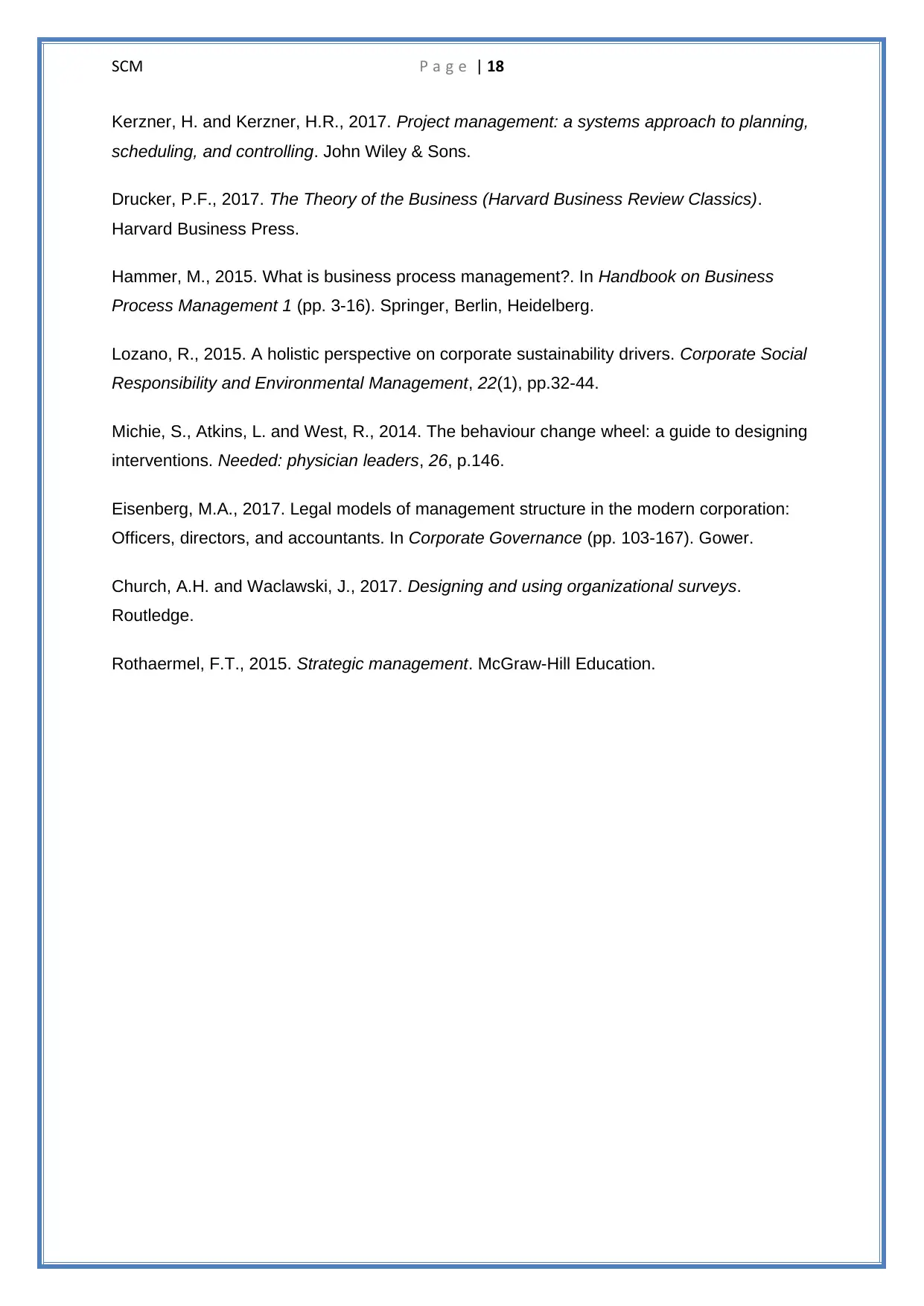
SCM P a g e | 18
Kerzner, H. and Kerzner, H.R., 2017. Project management: a systems approach to planning,
scheduling, and controlling. John Wiley & Sons.
Drucker, P.F., 2017. The Theory of the Business (Harvard Business Review Classics).
Harvard Business Press.
Hammer, M., 2015. What is business process management?. In Handbook on Business
Process Management 1 (pp. 3-16). Springer, Berlin, Heidelberg.
Lozano, R., 2015. A holistic perspective on corporate sustainability drivers. Corporate Social
Responsibility and Environmental Management, 22(1), pp.32-44.
Michie, S., Atkins, L. and West, R., 2014. The behaviour change wheel: a guide to designing
interventions. Needed: physician leaders, 26, p.146.
Eisenberg, M.A., 2017. Legal models of management structure in the modern corporation:
Officers, directors, and accountants. In Corporate Governance (pp. 103-167). Gower.
Church, A.H. and Waclawski, J., 2017. Designing and using organizational surveys.
Routledge.
Rothaermel, F.T., 2015. Strategic management. McGraw-Hill Education.
Kerzner, H. and Kerzner, H.R., 2017. Project management: a systems approach to planning,
scheduling, and controlling. John Wiley & Sons.
Drucker, P.F., 2017. The Theory of the Business (Harvard Business Review Classics).
Harvard Business Press.
Hammer, M., 2015. What is business process management?. In Handbook on Business
Process Management 1 (pp. 3-16). Springer, Berlin, Heidelberg.
Lozano, R., 2015. A holistic perspective on corporate sustainability drivers. Corporate Social
Responsibility and Environmental Management, 22(1), pp.32-44.
Michie, S., Atkins, L. and West, R., 2014. The behaviour change wheel: a guide to designing
interventions. Needed: physician leaders, 26, p.146.
Eisenberg, M.A., 2017. Legal models of management structure in the modern corporation:
Officers, directors, and accountants. In Corporate Governance (pp. 103-167). Gower.
Church, A.H. and Waclawski, J., 2017. Designing and using organizational surveys.
Routledge.
Rothaermel, F.T., 2015. Strategic management. McGraw-Hill Education.
Paraphrase This Document
Need a fresh take? Get an instant paraphrase of this document with our AI Paraphraser

SCM P a g e | 19
References
References
1 out of 20
Related Documents
Your All-in-One AI-Powered Toolkit for Academic Success.
+13062052269
info@desklib.com
Available 24*7 on WhatsApp / Email
![[object Object]](/_next/static/media/star-bottom.7253800d.svg)
Unlock your academic potential
© 2024 | Zucol Services PVT LTD | All rights reserved.





